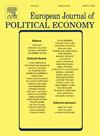批准与参与法定人数
IF 2.4
3区 经济学
Q2 ECONOMICS
引用次数: 0
摘要
使用关键的昂贵投票模型,我们分析了参与和批准法定人数要求(分别或联合应用)如何影响投票率、选举结果和福利。为了描述最优法定人数规则,我们首先表明,同等严格的参与和批准法定人数通常会产生相似的结果,除非这两种设置导致在选民是否可以协调参与方面不同的均衡。其次,任何仲裁类型的组合都可以被单独的批准或参与仲裁所取代,对平衡的影响可以忽略不计或没有影响。利用这些结果,我们建议,为了使投票率最大化,没有法定人数是最优的,除非预期的低现状支持,在这种情况下,严格的批准法定人数是首选。为了增加维持现状获胜的机会,严格的批准法定人数或没有法定人数是最好的办法。从选民福利的角度来看,投票法定人数接近一半或根本没有法定人数都是合理的选择。这些结果无论我们使用贝叶斯纳什均衡还是量子响应均衡作为解决概念都是成立的。本文章由计算机程序翻译,如有差异,请以英文原文为准。
Approval vs. participation quorums
Using a pivotal costly voting model, we analyze how participation and approval quorum requirements, applied separately or jointly, affect turnout, election outcomes, and welfare. To characterize an optimal quorum rule, we first show that equally strict participation and approval quorums often yield similar outcomes, unless the two settings result in equilibria that differ in terms of whether voters can coordinate on participation. Second, any combination of quorum types can be replaced by either an approval or participation quorum alone, with negligible or no impact on equilibrium. Using these results, we suggest that to maximize turnout, no quorum is optimal unless low status quo support is expected, in which case a strict approval quorum is preferred. To increase the status quo’s chances of winning, a strict approval quorum or no quorum works best. From a voter welfare perspective, an approval quorum near half the electorate or no quorum at all are reasonable choices. These results hold whether we use Bayesian Nash equilibrium or quantal response equilibrium as the solution concept.
求助全文
通过发布文献求助,成功后即可免费获取论文全文。
去求助
来源期刊

European Journal of Political Economy
Multiple-
CiteScore
3.40
自引率
10.00%
发文量
106
期刊介绍:
The aim of the European Journal of Political Economy is to disseminate original theoretical and empirical research on economic phenomena within a scope that encompasses collective decision making, political behavior, and the role of institutions. Contributions are invited from the international community of researchers. Manuscripts must be published in English. Starting 2008, the European Journal of Political Economy is indexed in the Social Sciences Citation Index published by Thomson Scientific (formerly ISI).
 求助内容:
求助内容: 应助结果提醒方式:
应助结果提醒方式:


